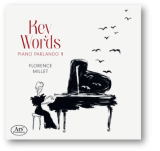Die 1964 geborene französische Pianistin Florence Millet, die als Solistin und Kammermusikern (u.a mit dem von ihr in den USA gegründeten Lions Gate Trio) bekannt ist, hat mit Keywords ein Album herausgegeben, auf dem ‘key’ sowohl für die Klaviertaste als auch den Schlüssel steht. Das Programm will der Grundfrage musikalischer Interpretation und Komposition nachgehen « wie man mit Musik Menschen anspricht ». Im Textheft steht: « Damit ist nicht die Vorstellung gemeint, Musik irgendwie zum Sprechen zu bringen. Vielmehr sind es selbst ‘sprechende’ Werke, also Klaviermusik, die dezidierte oder verborgene Botschaften enthält, sich auf Gedichte bezieht, Sprache, Wörter oder Silben mit einbezieht, Dialoge und Zwiegespräche führt, als Tagebuch gelesen werden kann oder ganze Geschichten erzählt. Und es ist auch das Instrument Klavier selbst, das in ‘Stimmen’ – flüsternd, stotternd, rufend, zögernd – auftritt. »
Das reicht dann von Peter Ablingers Voices and Piano, ein Stück in dem die Stimmen von Hanna Schygulla und Guillaume Apollinaire zugespielt werden, über Bachs programmatiscxhes Capriccio über die Abreise seines geliebten Bruders, Mompous Dialoge, Conversation X von Asperghis, Janaceks Intime Skizzen und weiteren Stücken bis zum Endpunkt, der Gnossienne Nr. 3 von Erik Satie.
Es ist also trotz des roten Fadens ein recht abwechslungsreiches Programm, in dem die sehr ausdrucksvoll gespielte Interpretation von Bachs Capriccio und Kurtags ‘Leises Gespräch mit dem Teufel’ sowie das Stück von Satie besonders gut gefallen. Janaceks Intimen Skizzen hingegen fehlen gerade die Intimität, das Verhaltene, das Mysteriöse.…
Die Tonaufnahme ist sehr klar und angenehm räumlich.
French pianist Florence Millet, born in 1964 and known as a soloist and chamber musician (including with the Lions Gate Trio, which she founded in the United States), has released Keywords, an album in which « key » stands for both the piano key and the key. The program aims to explore the fundamental question of musical interpretation and composition: « How do you speak to people with music? » The booklet states: « This does not mean the idea of somehow making music speak. Rather, it is about ‘speaking’ works themselves, i.e. piano music that contains explicit or hidden messages, refers to poetry, incorporates language, words or syllables, conducts dialogues and dialogues, can be read as a diary, or tells entire stories. And it is also the piano itself that appears in ‘voices’ – whispering, stuttering, calling, hesitating. »
This ranges from Peter Ablinger’s Voices and Piano, a piece in which the recorded voices of Hanna Schygulla und Guillaume Apollinairare added, to Bach’s programmatic Capriccio about the departure of his beloved brother, Mompou’s Dialogues, Conversation X by Asperghis, Janacek’s Intimate Sketches and other pieces, to the end point, Gnossienne No. 3 by Erik Satie.
Despite the common thread, this is a very varied program, in which the expressive interpretation of Bach’s Capriccio and Kurtag’s Quiet Conversation with the Devil, as well as the piece by Satie, are particularly pleasing. Janacek’s Intimate Sketches, on the other hand, lack intimacy, manner and mystery….
The recorded sound is very clear and pleasantly spacious.






















